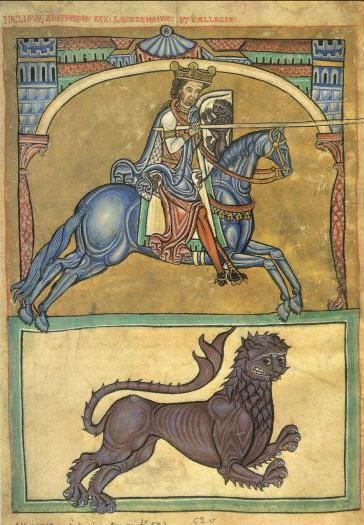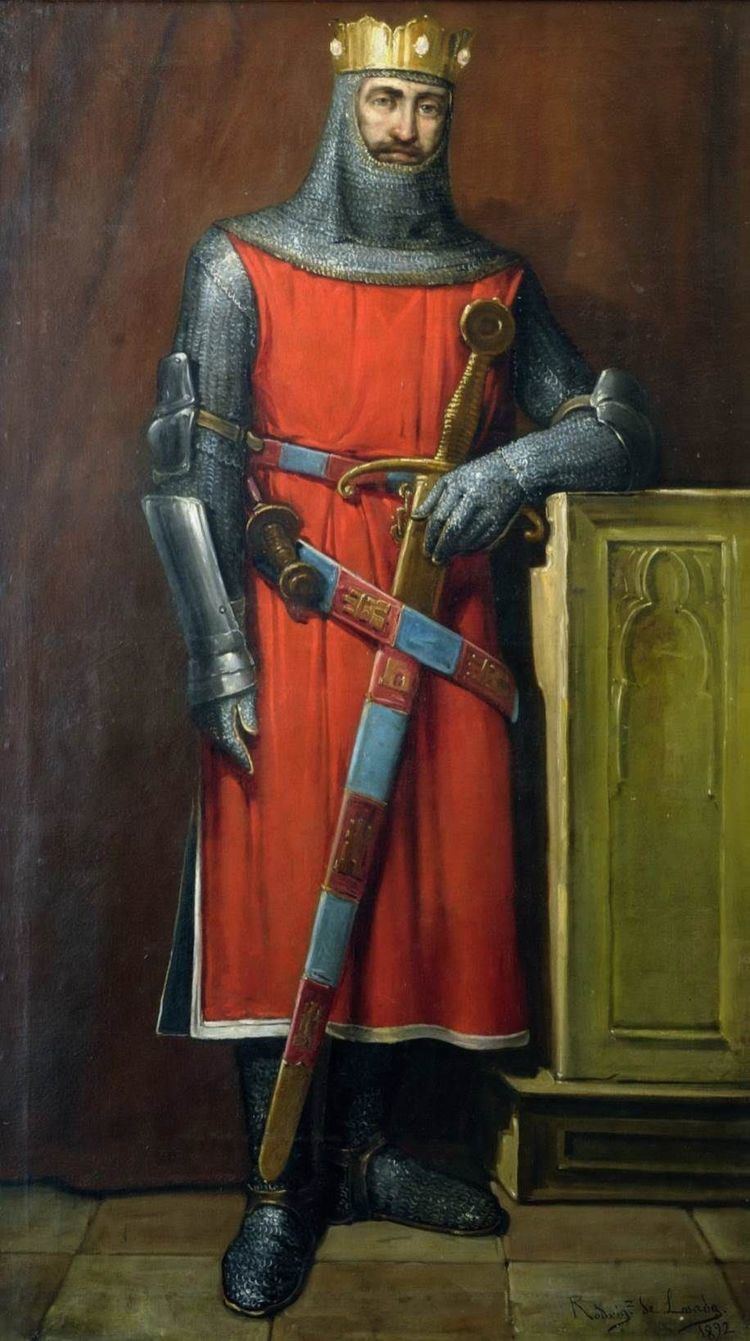Name Alfonso of | ||
 | ||
Reign 22 January 1188 – 24 September 1230 Born 15 August 1171Zamora ( 1171-08-15 ) Burial Cathedral of Santiago de Compostela Consort Theresa of PortugalBerengaria of Castile | ||
Alfonso IX of León
Alfonso IX (15 August 1171 – 23 or 24 September 1230) was king of León and Galicia from the death of his father Ferdinand II in 1188 until his own death. According to Ibn Khaldun (1332–1406), he is said to have been called the Baboso or Slobberer because he was subject to fits of rage during which he foamed at the mouth.
Contents

He took steps towards modernizing and democratizing his dominion and founded the University of Salamanca in 1212. In 1188 he summoned the first parliament reflecting full representation of the citizenry ever seen in Western Europe, the Cortes of León.
He took a part in the work of the Reconquest, conquering the area of Extremadura (including the cities of Cáceres and Badajoz).
Family
Alfonso was born in Zamora. He was the only son of King Ferdinand II of León and Urraca of Portugal. His father was the younger son of Alfonso VII of León and Castile, who divided his kingdoms between his sons, which set the stage for conflict in the family until the kingdoms were re-united by Alfonso IX's son Ferdinand III of Castile.
Reign
Alfonso IX had great difficulty in obtaining the throne through his given birthright. In July 1188 his cousin Alfonso VIII of Castile required the younger Alfonso to recognize the elder as overlord in exchange for recognizing the younger's authority in León.
The convening of the Cortes de León in the cloisters of the Basilica of San Isidoro would be one of the most important events of Alfonso's reign. The difficult economic situation at the beginning of his reign compelled Alfonso to raise taxes on the underprivileged classes, leading to protests and a few towns revolts. In response the king summoned the Cortes, an assembly of nobles, clergy and representatives of cities, and subsequently faced demands for compensatory spending and greater external control and oversight of royal expenditures. Alfonso's convening of the Cortes is considered by many historians, including Australia's John Keane, to be instrumental to the formation of democratic parliaments across Europe. Note that Iceland had already held what may have been what is Europe's first parliament, the Þingvellir, in 930 CE. However, the Cortes' 1188 session predates the first session of the Parliament of England, which occurred in the thirteenth century.
In spite of the democratic precedent represented by the Cortes and the founding of the University of Salamanca, Alfonso is often chiefly remembered for the difficulties his successive marriages caused between him with Pope Celestine III. He was first married in 1191 to his first cousin, Theresa of Portugal, who bore him two daughters, and a son who died young. The marriage was declared null by the papal legate Cardinal Gregory for consanguinity.
After Alfonso VIII of Castile was defeated at the Battle of Alarcos, Alfonso IX invaded Castile with the aid of Muslim troops. He was summarily excommunicated by Pope Celestine III. In 1197, Alfonso IX married his first cousin once removed, Berengaria of Castile, to cement peace between León and Castile. For this second act of consanguinity, the king and the kingdom were placed under interdict by representatives of the Pope. In 1198, Pope Innocent III declared Alfonso and Berengaria's marriage invalid, but they stayed together until 1204. The annulment of this marriage by the pope drove the younger Alfonso to again attack his cousin in 1204, but treaties made in 1205, 1207, and 1209 each forced him to concede further territories and rights. The treaty in 1207 is the first existing public document in the Castilian dialect.
The Pope was, however, compelled to modify his measures by the threat that, if the people could not obtain the services of religion, they would not support the clergy, and that heresy would spread. The king was left under interdict personally, but to that he showed himself indifferent, and he had the support of his clergy.
Children
In 1191, he married Theresa of Portugal, daughter of King Sancho I of Portugal and Queen Dulce of Aragon. Between 1191 and 1196, the year in which their marriage was annulled, three children were born:
On 17 November 1197 he married infanta Berengaria of Castile, daughter of King Alfonso VIII of Castile and Leonor of England. Five children were born of this marriage:
Alfonso also fathered many illegitimate children. After the annulment of his first marriage and before wedding Berengaria, he had a relationship which lasted about two years with Inés Íñiguez de Mendoza, daughter of Iñigo López de Mendoza and María García, with whom he had a daughter born around 1197:
He had another relationship afterwards with a noblewoman from Galicia, Estefanía Pérez de Faiam. In 1211, King Alfonso gave her lands in Orense where her family, as can be inferred from her last will dated 1250, owned many estates, as well as in the north of Portugal. She was the daughter of Pedro Menéndez Faiam, who confirmed several royal charters of King Alfonso IX, and granddaughter of Menendo Faiam, who also confirmed several diplomas issued in Galicia as of 1155 by King Ferdinand II of León. After the relationship ended, Estefanía married Rodrigo Suárez with whom she had issue. In her will, she asked to be buried in the Monastery of Fiães in northern Portugal.
Alfonso IX and Estefanía were the parents of:
According to Spanish historian, Julio González, after his relationship with Estefanía, the king had a lover from Salamanca, of unknown origin, whose name was Maura and with whom he had:
Of his relationship with the noblewoman from Portugal, Aldonza Martínez de Silva, daughter of Martim Gomes da Silva and his wife Urraca Rodrigues, which lasted from 1214 to 1218, three children were born:
King Alfonso's most long-lasting relationship, which began in 1218 and lasted until his death in 1230, was with Teresa Gil de Soverosa. A member of the Portuguese nobility, Teresa was the daughter of Gil Vasques de Soverosa and his first wife María Aires de Fornelos. They had four children, all of them born between 1218 and 1239:
Although Alfonso IX is supposed to have had another son, Pedro Alfonso de León, there is no documentary proof that he was the king's son or that he was the Grand Master of the Order of Santiago.
Death
Alfonso IX of León died on 24 September 1230. His death was particularly significant in that his son, Ferdinand III of Castile, who was already the King of Castile also inherited the throne of León from his father. This was thanks to the negotiations of his mother, Berengaria, who convinced her stepdaughters to renounce their claim on the throne. In an effort to quickly consolidate his power over León, Ferdinand III abandoned a military campaign to capture the city of Jaén immediately upon hearing news of his father's death and traveled to León to be crowned king. This coronation united the Kingdoms of León and Castile which would go on to dominate the Iberian Peninsula.
